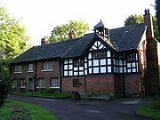
Clayton Hall
Encyclopedia
Clayton Hall is on Ashton New Road, in Clayton
, Manchester
, hidden behind trees in a small park. The Hall is a Grade II* listed building, a scheduled ancient monument
, and is a rare example of a medieval moat
ed site .
The hall was probably built in the 15th century and is surrounded by a moat, making an island 66 m by 74 m. Alterations were made to the hall in the 16th and 17th centuries, and enlarged in the 18th century. Originally built for the Clayton Family, it passed on into the hands of the Byron family—of which poet Lord Byron was a member—in 1194. They lived there until they sold it to two London merchants, George and Humphrey Chetham, in 1620. Humphrey Chetham
is famous for founding Cheethams School and Library
in the centre of Manchester. After an eventful life, Chetham died at the Hall in 1653.
The Hall was then to be acquired by Manchester City Corporation in 1897, ensuring the survival of this romantic link with the past in a most unlikely area. The section on the right of the Hall is the older half, dating back to the 16th century. The section of the Hall on the left dates back from the 18th century and contained the dining room, kitchen, larder, scullery and pantry of the Hall.
During the Civil War, Royalist
cavalry were stationed here, before the attack on Manchester. Afterwards, according to legend, Oliver Cromwell
was said to have spent three nights at the Hall.
The oldest surviving structure on the site is the sandstone bridge crossing the (now empty) moat. Dating from the late medieval era, it was built to replace an original wooden drawbridge over the moat. The moat is planned to reline and fill.
Clayton, Greater Manchester
Clayton is a suburb of the city of Manchester, in North West England. It is situated about 3 miles east of the city centre, on Ashton New Road. Clayton takes its name from the Clayton family who owned large parts of land around the area, including Clayton Vale, through which the River Medlock flows...
, Manchester
Manchester
Manchester is a city and metropolitan borough in Greater Manchester, England. According to the Office for National Statistics, the 2010 mid-year population estimate for Manchester was 498,800. Manchester lies within one of the UK's largest metropolitan areas, the metropolitan county of Greater...
, hidden behind trees in a small park. The Hall is a Grade II* listed building, a scheduled ancient monument
Scheduled Ancient Monument
In the United Kingdom, a scheduled monument is a 'nationally important' archaeological site or historic building, given protection against unauthorized change. The various pieces of legislation used for legally protecting heritage assets from damage and destruction are grouped under the term...
, and is a rare example of a medieval moat
Moat
A moat is a deep, broad ditch, either dry or filled with water, that surrounds a castle, other building or town, historically to provide it with a preliminary line of defence. In some places moats evolved into more extensive water defences, including natural or artificial lakes, dams and sluices...
ed site .
The hall was probably built in the 15th century and is surrounded by a moat, making an island 66 m by 74 m. Alterations were made to the hall in the 16th and 17th centuries, and enlarged in the 18th century. Originally built for the Clayton Family, it passed on into the hands of the Byron family—of which poet Lord Byron was a member—in 1194. They lived there until they sold it to two London merchants, George and Humphrey Chetham, in 1620. Humphrey Chetham
Humphrey Chetham
Sir Humphrey Chetham was an English merchant, responsible for the creation of Chetham's Hospital and Chetham's Library, the oldest public library in the English-speaking world.- Life :...
is famous for founding Cheethams School and Library
Chetham's Library
Chetham's Library in Manchester, England is the oldest free public reference library in the United Kingdom. Chetham's Hospital, which contains both the library and Chetham's School of Music, was established in 1653 under the will of Humphrey Chetham , for the education of "the sons of honest,...
in the centre of Manchester. After an eventful life, Chetham died at the Hall in 1653.
The Hall was then to be acquired by Manchester City Corporation in 1897, ensuring the survival of this romantic link with the past in a most unlikely area. The section on the right of the Hall is the older half, dating back to the 16th century. The section of the Hall on the left dates back from the 18th century and contained the dining room, kitchen, larder, scullery and pantry of the Hall.
During the Civil War, Royalist
Cavalier
Cavalier was the name used by Parliamentarians for a Royalist supporter of King Charles I and son Charles II during the English Civil War, the Interregnum, and the Restoration...
cavalry were stationed here, before the attack on Manchester. Afterwards, according to legend, Oliver Cromwell
Oliver Cromwell
Oliver Cromwell was an English military and political leader who overthrew the English monarchy and temporarily turned England into a republican Commonwealth, and served as Lord Protector of England, Scotland, and Ireland....
was said to have spent three nights at the Hall.
The oldest surviving structure on the site is the sandstone bridge crossing the (now empty) moat. Dating from the late medieval era, it was built to replace an original wooden drawbridge over the moat. The moat is planned to reline and fill.

